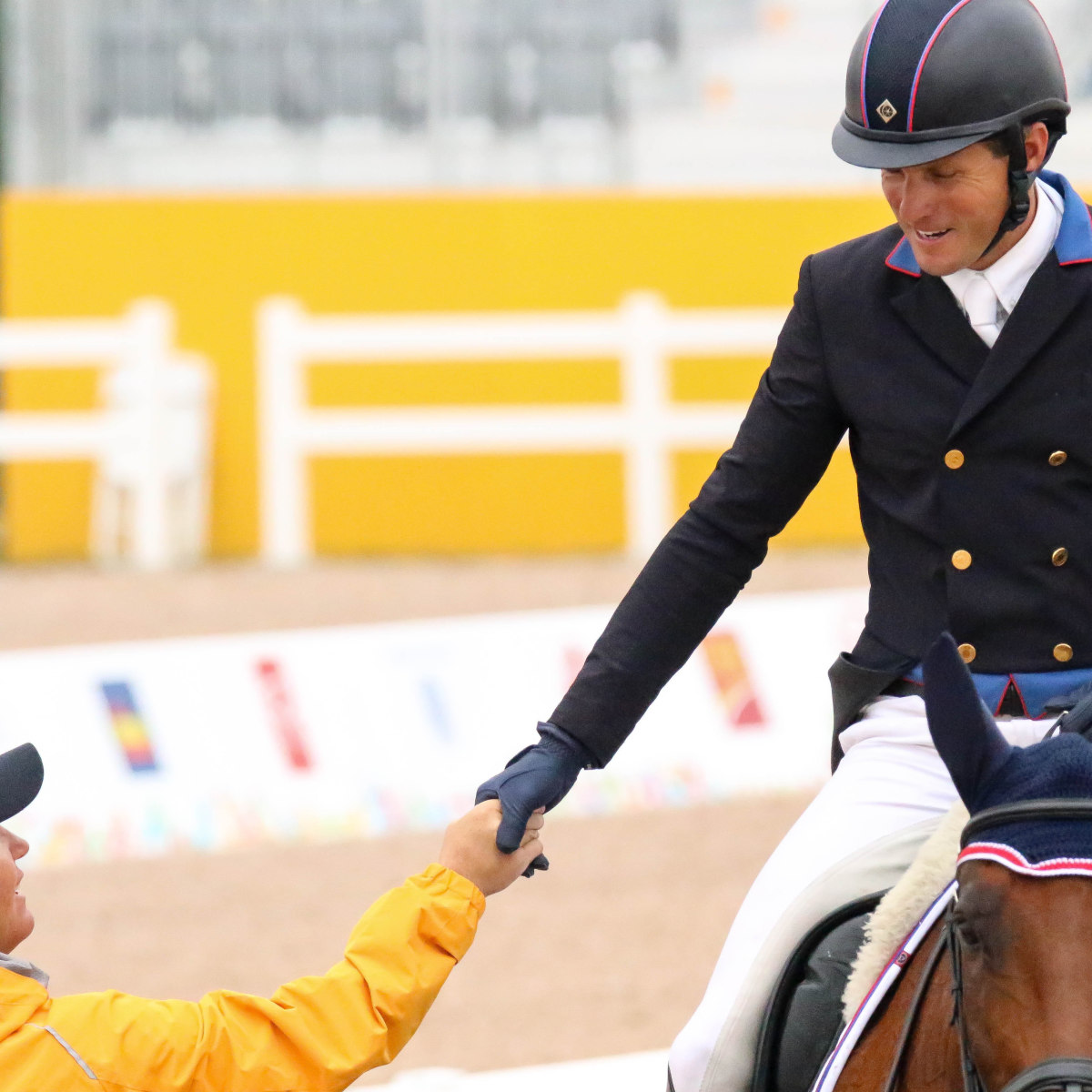In Fit & Focused in 52, author Daniel Stewart gives readers one exercise for the mind and one exercise for the body for every week of the year. In this adapted excerpt: his philosophy, how to plan a program with the weekly focus and fitness tips and the first week’s lesson.
Your ability to release your inner greatness depends on a series of important physical and mental skill sets. For example, you might have the world’s best leg, seat, position and posture, but if you’re constantly freaking out, panicking, hyperventilating and worrying before every ride, there’s a pretty good chance your brain is going to hold your body back. Likewise, you might have the world’s best focus, confidence, willpower and optimism, but if your muscles are constantly burning and you don’t have any core strength, stamina or balance, there’s a really good chance your body is going to hold your brain back. Only when your physical and mental abilities come together—when brain and body meet and your frame and frame of mind become one—are you really able to truly tap into your inner greatness.
If you’re like most equestrians, you’ve probably spent years developing your hips, heels and hands because you know they’re a major key to your success as a rider. You’ve probably also spent countless hours developing your horse because you also know that without a confident partner, there’s little chance you’ll succeed. Fit & Focused in 52 applauds you for working so hard on your hips, heels, hands and horse but wants to remind you that your puzzle is still missing a few important pieces—your head, health and heart!
Your head is where confidence, courage, self-belief and resiliency are born. Your health is how you prepare for (and protect your body against) the physical demands of our sport. And your heart is where your ability to forgive yourself after making a mistake—or finish strong after a slow start—resides. Combine them all together and they create the ability to turn setbacks into comebacks—to hold it together when it would be easier to let it fall apart. This is what it means to be a complete rider: an athlete who dedicates his or her life to building strong hips, heels, hands, horse, head, health and heart.
Introduction to the 52 Focus Tips
Let’s start with some really good news. Your brain is designed to focus on one—and only one—thing at a time. This means that when you’re focusing on the good stuff, your brain can’t think of the bad stuff! It operates by doing something called selective attention: you select what you’re going to pay attention to because you can only focus on one thing at a time, and this is the entire purpose for the 52 mental training focus tips: to keep your brain so focused on the positive that it won’t have the time or ability to focus on the negative!
Begin each week by reading the new focus tip and spend the remainder of the day simply thinking about it. There’s no rush—you’ll have plenty of time to complete the homework before the next tip arrives the following week. On Day Two, start to direct your thoughts toward how you plan to complete your focus homework. It might come easily—just sort of popping out at you—or it might take several days to come to you. Share it with your friends, family and riding-mates—it’s usually much more enjoyable when done with a group.
Even if you can’t complete your homework before the following week’s tip, don’t give up. Just put it to the side for a while and revisit it from time to time. When you finally complete it, be sure to write it down or even make yourself a special FF52 logbook to keep it in along with any notes.
Introduction to the 52 Fitness Exercises
In conjunction with the 52 focus tips, each week I also present you with a new strength and conditioning fitness exercise.
How to plan your program: Every week for the year ahead, I’ll give you a new fitness exercise. But you know that you can’t build a fitness program on one exercise alone! With this in mind, I’d like you to spend the first full day of each week simply practicing the new exercise. Read the instructions and follow them along with the photos until you’re able to complete it without trouble.
On Day Two, add this new exercise to the FF52 four sport-specific, fundamental exercises: the equestrian squats, jumper jacks, canter crunches and the squat thrust. Begin by performing your new exercise, then follow it with the other four exercises (you can pick the order) for one full minute each (for a total of five minutes), then repeat all five again twice more. In the end, you’ll have completed a full 15 minutes of fitness consisting of five different exercises (done three times each). Add in a five-minute stretching session at the end and you’ll have a fantastic 20-minute workout to do every other day the remaining days of the week.
In the weeks that follow, simply remove one of the five exercises from the previous week (keeping four of them) and replace it with the new week’s exercise. In this way, your five-part fitness program will be ever-changing and varied, which is important to ensure the overall health of your body while also helping you avoid burnout and boredom.
Week 1 Focus Tip: The Five-Second Favor
The world’s best way to improve your happiness and self-confidence is to come up with a bunch of wonderful things you can do to make other people happy. Believe it or not (but believe it, because it’s true) every time you perform a random act of kindness, you actually receive as much benefit as the recipient—and in some cases even more! Offering to help someone clean the wash rack or to hold her horse while she fetches her helmet might seem like a pretty simple gesture, but five-second and five-minute favors like these actually stimulate your brain’s pleasure center, causing it to release chemicals that pump up your optimism and self-esteem. If that weren’t enough (and it could be), it also creates something called a positive feedback loop, meaning that the happiness you give to people inspires them to want to be kinder to others as well. Now that’s the kind of world you and your horse deserve to live in!

Kindness is contagious: A man purchased a box of cookies at a supermarket, opened it while at the checkout counter and gave a cookie to everyone waiting in line. He said he was having a bad day, but knew it would get better if he did something nice for somebody. After reading the story, I ordered an extra pizza and gave a piece to everyone waiting in line for a table at the restaurant. It’s true—kindness is contagious!
Did you know? You’re better at doing random acts of kindness for animals (pick up the poop!) than for people. You’re also better at being kind to others than you are at being kind to yourself. Hmmmm … .
Week 1 Fitness Exercise: Jumper Jacks
Your very first exercise is the FF52 Fundamental Exercise 2 that I referred to earlier: You’re learning how to turn regular jumping jacks into amazing equestrian jumper jacks. Here’s how you’re going to do it:
Do three sets of 10 reps at a rate that is moderately difficult. You’ll know you’re on the right track if you can talk, but it requires a bit of effort. It might feel like cantering a somewhat difficult-to-control horse for a few minutes. Increase reps and/or sets if it becomes too easy.
Challenge yourself: Once you get the hang of your jumper jacks, increase the challenge by making two small marks on the floor with pieces of tape, one under each foot in the starting (wide) position. Begin your jumper jacks and make an effort to land on the taped spots each time. Once you’ve gotten the hang of it, close your eyes and perform 10 blind jumper jacks. When you finish, look down. Did you land on both pieces of tape? If not, reset and repeat. This is not only a great way to improve your body awareness and symmetry, it’s also a great way to trick yourself into doing 10 more jumper jacks!
Daniel Stewart has been a successful international trainer and instructor for over 30 years, working with riders in the United States, Spain, Portugal, England, Canada, Mexico, Switzerland, Belgium, the United Arab Emirates, Greece and the West Indies. From 1999 to 2007 he coached riders on several U.S. Equestrian Teams at World Championships, World Equestrian Games and the Olympics. Daniel teaches riding clinics and seminars to thousands of riders each year and is currently a consultant for US Equestrian and USA Pentathlon. He’s a sought-after keynote speaker for many national conventions and is the equestrian sport-psychology expert for the U.S. Eventing Association, U.S. Pony Clubs and U.S. Hunter Jumper Association as well as other equestrian organizations. Widely considered one of the world’s leading experts on equestrian sport psychology, athletics and performance, Daniel is the author of three books and produces weekly equestrian sport-psychology video tips, rider-fitness video classes and instructor-certification videos through his Pressure Proof Academy. He teaches multi-day Equestrian Athlete Camps at some of America’s most elite athlete training centers, helping riders prove that they are athletes. When not on the road, he resides in Naples, Florida.

Adapted from Fit & Focused in 52 by Daniel Stewart with permission of Trafalgar Square Publishing. Hardcover, 184 pages, $27.95
This article was originally published in the March 2018 issue.










